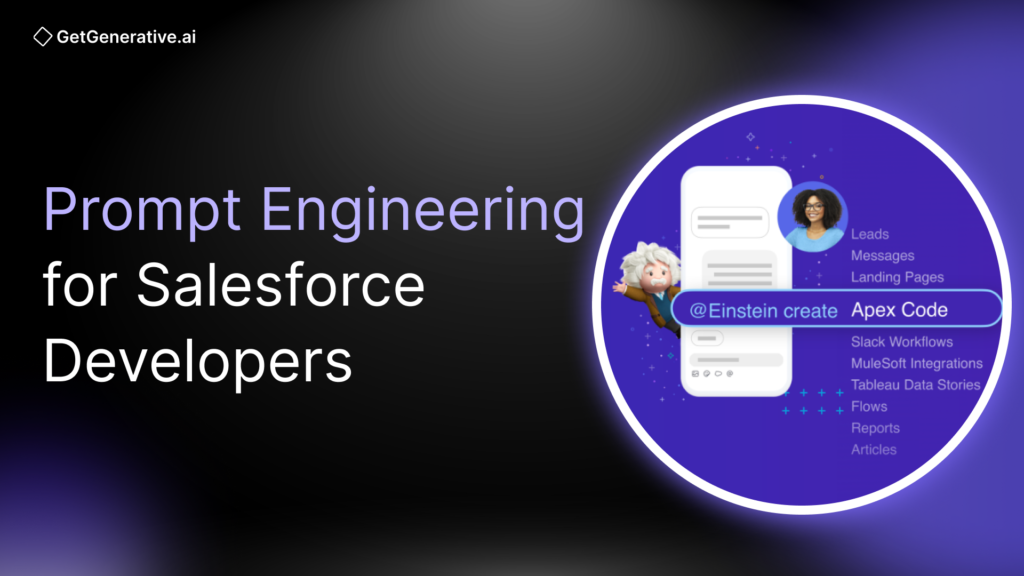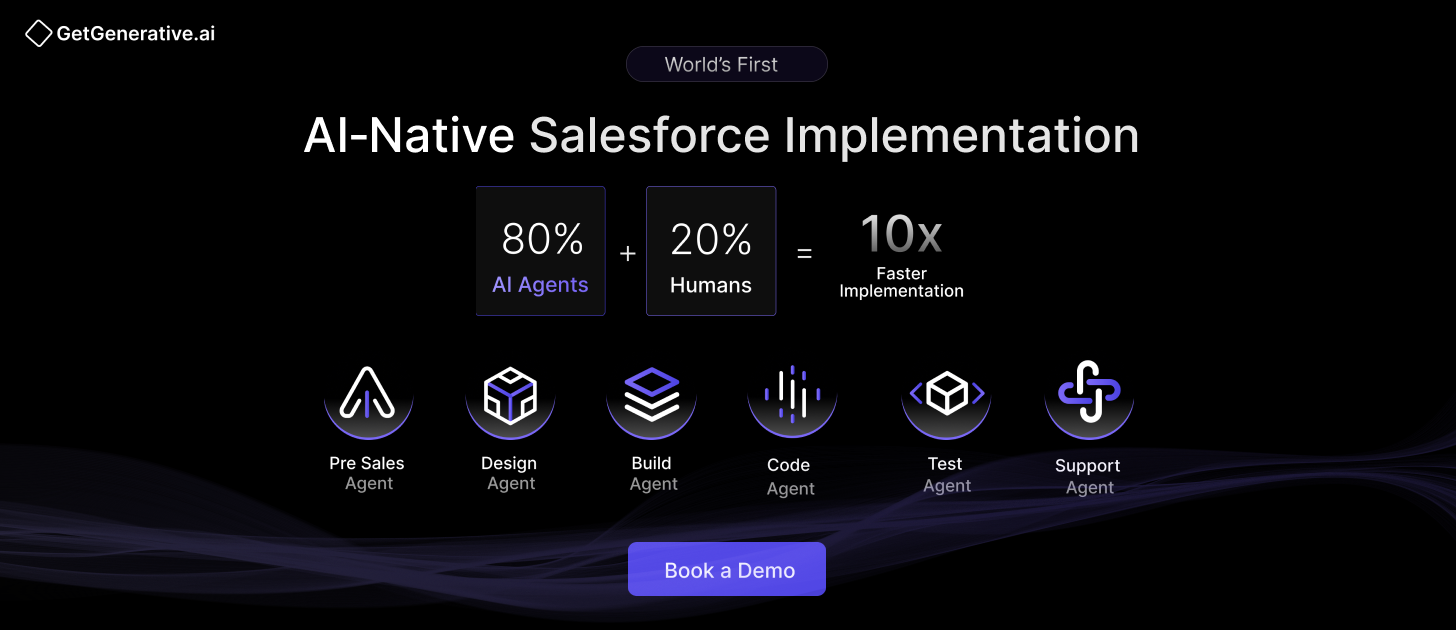Prompt Engineering for Salesforce Developers
The rise of generative AI has reshaped software development. Tools like OpenAI’s ChatGPT and Salesforce’s Einstein GPT are no longer fringe experiments — they’re rapidly becoming embedded in the daily workflows of developers and architects across the Salesforce ecosystem.
According to the Stack Overflow Developer Survey,
- 76% of developers are using or planning to use AI tools.
- 74% of ChatGPT users intend to continue using it long-term.
Salesforce’s own research confirms this trend:
61% of professionals in Salesforce roles already use or plan to use generative AI in their jobs.
From generating Apex classes and SOQL queries to simulating user interactions and writing test cases, AI has the potential to transform how developers build on Salesforce. But tapping into that power effectively requires more than just clicking a button — it requires a new skillset:
👉 Prompt engineering — the art of crafting natural-language inputs that guide AI to produce precise, usable, and secure outputs.
This blog will explore what prompt engineering means in a Salesforce context, how it can supercharge developer productivity, and how to apply it effectively using tools like Einstein GPT, Prompt Builder, and ChatGPT. Let’s get started!
What Is Prompt Engineering?
Prompt engineering is the discipline of designing high-quality prompts to steer generative AI models (like GPT-4) toward specific, useful outputs. A prompt is simply the input text you feed into the AI, but its wording, structure, and clarity can significantly impact the outcome.
Effective prompts act like functional specifications — they guide the AI like requirements documents guide developers.
For example, instead of typing “write Apex code”, you might craft:
“You are a senior Salesforce developer. Write an Apex trigger that updates a Last_Contact__c field when a Case is closed.”
That one sentence provides role context, a clear objective, and data references — helping the AI generate more accurate code.
Key Components of an Effective Prompt:
- Role declaration: Define the AI’s “persona” (e.g., Salesforce dev, data architect).
- Contextual grounding: Include relevant CRM data, object names, or business rules.
- Task specificity: State exactly what you want — a formula, a code snippet, a flow.
- Format constraints: Specify the desired output format (e.g., JSON, Apex class).
- Few-shot examples: Provide example inputs/outputs for better learning.
Why Prompt Engineering Matters for Salesforce Developers
In the Salesforce ecosystem, prompt engineering is fast becoming as important as knowing Apex or SOQL.
Why? Because AI tools are now deeply integrated into Salesforce workflows:
- Einstein GPT and Prompt Builder generate CRM content, metadata, and code.
- ChatGPT and Copilot assist with testing, optimization, and documentation.
- Slack, Service Cloud, and Flow now support generative AI chat and logic blocks.
Developers who master this skill can:
- Cut boilerplate coding time by up to 70%
- Generate test classes, flows, and documentation in minutes instead of hours
- Focus on high-level problem-solving instead of repetitive tasks
In addition, a well-designed prompt helps non-developers collaborate more effectively. Admins, product managers, and architects can use structured prompts to:
- Draft user stories and test cases
- Translate business requirements into flow logic
- Generate customer email templates and help content
But for AI to be a reliable co-pilot, it must be guided by someone who understands the platform deeply, and that’s where Salesforce developers play a crucial role.
Inside Salesforce’s AI Ecosystem: Where Prompt Engineering Comes In
Salesforce’s generative AI ecosystem is rapidly expanding. Here’s a snapshot of what developers have access to in 2025:
Einstein GPT
Announced at TrailblazerDX, Einstein GPT blends OpenAI’s LLMs with your live CRM data. It can:
- Generate Apex, LWC, and SOQL
- Summarize records and conversations
- Auto-compose emails, field help, or user guidance
Einstein GPT is made secure via a Trust Layer that strips sensitive data before sending it to external models. Data is not stored, indexed, or remembered by the LLM, solving key enterprise adoption concerns.
Einstein Copilot Studio
A suite of low-code tools for building AI-powered experiences:
- Prompt Builder: Create structured, reusable prompts tied to CRM data
- Skills Builder: Design workflows activated by prompt triggers
- Model Builder: Bring in external or fine-tuned models securely
![Prompt Builder UI]
Visual: Side-by-side layout showing a structured prompt template and AI-generated output preview
Prompt Builder lets you:
- Insert dynamic record data into prompts (e.g. {$Input:Contact.FirstName})
- Define expected outputs (e.g. bullet list, JSON, plain text)
- Preview and test results live
These tools turn prompt engineering into an enterprise-grade process, with testing, versioning, and governance.
Also Read – Getting Started with Code Builder and Agenforce in Salesforce
Core Prompt Engineering Techniques for Salesforce Developers
To get the best from Salesforce AI tools, developers must apply tried-and-true prompt engineering techniques.
Here are the top strategies:
✅ Define the AI’s Role
“You are a Salesforce Apex developer with 10+ years of experience. Respond concisely and in code only.”
This frames the model’s response style and narrows scope.
✅ Use Delimiters for Context
Use ### Instructions: and ### Input: or triple backticks (“`) to separate your instructions from data/code.
Example:
trigger UpdateContactDate on Case (after update) {
// Trigger logic here
}
Prompt:
“Explain what the Apex trigger does. Code is between triple backticks.”
✅ Few-Shot Prompting
Show 1–2 examples of what you want before your real input.
Example:
Input: “Customer is unhappy with product delay”
Output: “Negative”
Input: [New Review]
Output: ???
This primes the model to follow your logic.
✅ Chain-of-Thought Prompting
For complex tasks, break the solution into steps.
“First, list all Opportunity stages. Then explain which ones are open. Then summarize in a table.”
This improves output structure and reduces hallucinations.
✅ Specify Output Format
“Respond with a JSON array containing fields: Name, Email, AccountID.”
Clear format expectations help automation and API use.
✅ Refine Iteratively
Prompt engineering is not “set it and forget it.” Tweak, test, and evolve your prompts. Start simple, add constraints, and test with different data.
Best Practices from OpenAI, Salesforce, and Google
Prompting Principle | Why It Works |
Instructions First | Models prioritize early text |
Positive Framing | Don’t say “Don’t do X” – say “Do Y” |
Explicit Output Types | Prevents guessing by the model |
Avoid Sensitive Data | Use pseudonyms or test data |
Use Prompt Templates | Standardize successful prompts for reuse |
Also Read – From Prompts to Prototypes: The Rise of AI-Driven Development in Salesforce
Top Use Cases of Prompt Engineering in Salesforce Development
Prompt engineering unlocks a powerful set of AI-driven capabilities across the Salesforce development lifecycle. Here are some of the most impactful applications with real-world examples:
1. Apex and LWC Code Generation
Prompt:
“Generate an Apex trigger that updates the Last_Contact__c field on the Account when a Case is closed.”
Output:
An entire functional Apex trigger with a handler class. Similarly, you can use prompts to:
- Scaffold Lightning Web Components (LWC)
- Generate test classes with @isTest
- Refactor legacy Apex using clean code principles
2. Metadata and Object Configuration
Prompt:
“Based on this PlantUML class diagram, generate the corresponding Salesforce object metadata in XML format.”
Use Cases:
- Generate object and field XML for Metadata API
- Create validation rules, formula fields, or Flow JSON
- Build translation files or picklist mappings
Example:
A data model described in bullet points can become deployable XML.
3. SOQL & Data Queries
Prompt:
“Write a SOQL query to find all Cases closed in the last 30 days, grouped by owner.”
AI responds with a syntactically correct and optimized SOQL query.
Use Cases:
- Complex joins using parent-child relationships
- Dynamic filtering based on business logic
- Script generation for batch processing
4. Test Class and QA Generation
Prompt:
“Create a test class for this Apex controller with at least 90% coverage.”
AI returns:
- @isTest annotated class
- Positive/negative test cases
- Mock data creation logic
Also useful for:
- Generating data factories
- Writing negative test paths
- Simulating edge cases
5. Documentation and Diagrams
Prompt:
“Convert this object relationship into a PlantUML diagram.”
Output:
Ready-to-use diagram code visualizing object models or integration flows. Also used for:
- Generating Mermaid.js flowcharts
- Creating ERDs
- Drafting user manuals and integration docs
6. Formulas, Automation & Validation Rules
Prompt:
“Write a validation rule to prevent Opportunities from being marked Closed–Won without a signed contract.”
Output:
A complete formula with proper syntax, error message, and testable conditions.
Also used for:
- Building custom formulas for KPIs
- Flow decision logic generation
- Suggesting Process Builder automation steps
7. Email, Content & Knowledge Article Generation
Prompt:
“Create a branded HTML email for a customer renewal reminder with placeholders for name, renewal date, and CTA.”
Output:
Complete HTML/CSS email template respecting brand tone.
Use Cases:
- Marketing Cloud content blocks
- Knowledge articles
- Pre-drafted case responses
8. Translations and Localization
Prompt:
“Translate the following 20 field labels and help texts to German for DACH markets.”
Use Cases:
- Support multilingual deployments
- Automate Translation Workbench inputs
- Generate regional-specific help content
9. Chatbots and Guided Help
Prompt:
“You are a Salesforce support bot. Help users reset a password without asking for PII.”
Used in:
- Einstein Bots
- Slack chat integrations
- Service Cloud guided assistance
Prompt design helps control bot tone, flow, and compliance.
Also Read – AI-Generated Code: When to Trust It and When to Intervene
Tools for Prompt Engineering in Salesforce
Here’s a breakdown of the key tools that enable prompt-driven development in Salesforce:
1. Prompt Builder (Beta)
- Create prompt templates with dynamic field bindings
- Use special tokens ({$Input:Record.Name}) for context
- Version prompts, test outputs, enforce formats
2. Einstein for Developers (Pilot)
- Salesforce-trained GPT model for Apex, LWC, and metadata
- Generates test classes, documentation, and suggestions in VS Code
3. VS Code Extensions
- Einstein GPT plugin to prompt directly from code
- Highlight Apex, right-click → “Generate Unit Test” or “Explain Code”
4. Flow Builder (Text Generation Element)
- Add “Generate Text” AI blocks to Flows
- Use prompts as part of decision-making logic
5. External AI (OpenAI, Azure)
- Connect LLMs to Salesforce via Apex callouts or MuleSoft
- Ensure secure token management and prompt logging
6. GitHub Copilot & Tabnine
- AI autocompletion in Apex, JS, HTML within Salesforce projects
- Complements prompt-driven code generation
Risks and Challenges to Watch Out For
While powerful, generative AI also introduces real risks:
1. Hallucinations
LLMs can generate fake methods or non-existent objects.
✅ Solution:
Always review AI output, especially code or SOQL queries.
2. Data Leakage
Prompts may expose PII if sent to external LLMs.
✅ Solution:
Use the Salesforce Trust Layer or sanitize data manually.
3. Compliance and Bias
Prompts may unintentionally trigger non-inclusive or non-compliant content.
✅ Solution:
Include tone and inclusivity instructions in prompts. Review outputs for bias.
4. Token Limits and Cost
GPT-4 has token caps and API costs. Large prompts = slower + more expensive.
✅ Solution:
Use compact prompts. Avoid verbose context unless needed.
5. Drift and Versioning
A prompt that worked last month may behave differently after a model upgrade.
✅ Solution:
Version prompts. Retest regularly. Lock models when possible.
Conclusion
Prompt engineering is no longer optional — it’s the gateway to generative productivity in Salesforce. With the rise of Einstein GPT, Prompt Builder, and Copilot Studio, developers can offload repetitive work to AI and focus on designing smarter, safer, and faster solutions.
At GetGenerative.ai, we’ve reimagined Salesforce implementation-built from the ground up with AI at the core. This isn’t legacy delivery with AI added on. It’s a faster, smarter, AI-native approach powered by our proprietary platform.
👉 Explore our Salesforce AI consulting services




